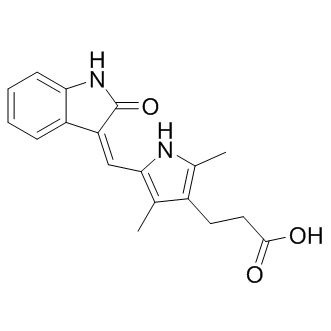| Description: |
Orantinib (SU6668; TSU-68) is a multi-targeted receptor tyrosine kinase inhibitor with Kis of 2.1 μM, 8 nM and 1.2 μM for Flt-1, PDGFRβ and FGFR1, respectively. |
| Target: |
Flt-1:2.1 μM (Ki)
PDGFRβ:0.008 μM (Ki)
FGFR1:1.2 μM (Ki) |
| In Vivo: |
Orantinib (SU6668; 75-200 mg/kg) causes tumor growth inhibition on several tumor types in xenograft models in athymic mice, such as A375, Colo205, H460, Calu-6, C6, SF763T, and SKOV3TP5 cells. Orantinib (75 mg/kg) also inhibits tumor angiogenesis of C6 glioma xenografts[1]. In a tumor model of HT29 human colon carcinoma, Orantinib (200 mg/kg) decreases the average vessel permeability and average fractional plasma volume in the tumor rim and core. Orantinib enhances abnormal stromal development at the periphery of carcinomas[3]. Moreover, Orantinib (TSU-68; 200 mg/kg) augments the effect of chemotherapeutic infusion in a rabbit VX2 liver tumor model[4]. |
| In Vitro: |
Orantinib (SU6668; 0.03-10 μM) shows inhibitory activity against tyrosine phosphorylation of KDR in VEGF stimulated HUVECs, and also blocks PDGF-stimulated PDGFRβ tyrosine phosphorylation in NIH-3T3 cells overexpressing PDGFRβ. Orantinib (≥10 μM) inhibits acidic FGF-induced phosphorylation of the FGFR1 substrate 2. However, Orantinib (up to 100 μM) has no effect on EGF-stimulated EGFR tyrosine phosphorylation in NIH-3T3 cells overexpressing EGFR. Furthermore, Orantinib inhibits VEGF-driven and FGF-driven mitogenesis of HUVECs with mean IC50 of 0.34 μM and 9.6 μM, respectively[1]. In human myeloid leukemia MO7E cells, Orantinib (SU6668) inhibits the tyrosine autophosphorylation of stem cell factor (SCF) receptor, c-kit, with IC50 of 0.1-1 μM, as well as ERK1/2 phosphorylation. In addition, Orantinib suppresses SCF-induced proliferation of MO7E cells with an IC50 of 0.29 μM, and induces apoptosis[2]. |
| Cell Assay: |
Cells are seeded (3×105 cells/35-mm well) in DMEM containing 10% (v/v) FBS and grow to confluence and then quiesced in DMEM containing 0.1% serum for 2 hours before drug treatment. HUVECs (seeded at 2×106 cells/10-cm plate) are grown to confluence in endothelial cell growth media and then quiesced in endothelial cell basal media containing 0.5% FBS for 24 hours before drug treatment. All cell lines are incubated with Orantinib for 1 hour before ligand stimulation (100 ng/mL) for 10 min. |
| Animal Administration: |
Colo205 and H460 cells are cultured in RPMI 1640 supplemented with 10% FBS and 2 mm glutamine. SKOV3 cells are passaged five times through mice to yield SKOV3TP5 cells. These cells are cultured in DMEM supplemented with 10% FBS and 2 mm glutamine. Tumor cells (3-10×106 cells/animal) are implanted s.c. into the hind flank of mice on day 0. Daily treatment with Orantinib or vehicle commenced 1 day after implantation of cells (to test efficacy against newly implanted tumors) or when tumors have reached a predetermined average size (to test efficacy against established tumors). Orantinib is delivered i.p. by bolus injection in DMSO or p.o. by gavage in a cremophor-based vehicle according to the specifics stated in figure and table legends. Tumor growth is measured twice a week using vernier calipers for the duration of treatment. Tumor volumes are calculated. |
| References: |
[1]. Laird AD, et al. SU6668 is a potent antiangiogenic and antitumor agent that induces regression of established tumors. Cancer Res, 2000, 60(15), 4152-4160.
[2]. Smolich BD, et al. The antiangiogenic protein kinase inhibitors SU5416 and SU6668 inhibit the SCF receptor (c-kit) in a human myeloid leukemia cell line and in acute myeloid leukemia blasts. Blood, 2001, 97(5), 1413-1421.
[3]. Marzola P, et al. In vivo assessment of antiangiogenic activity of SU6668 in an experimental colon carcinoma model. Clin Cancer Res, 2004, 10(2), 739-750.
[4]. Kim HC, et al. Augmentation of chemotherapeutic infusion effect by TSU-68, an oral targeted antiangiogenic agent, in a rabbit VX2 liver tumor model. Cardiovasc Intervent Radiol. 2012 Feb;35(1):168-75 |






















